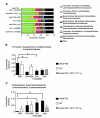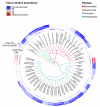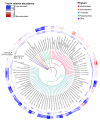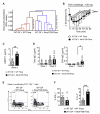A microbiota signature associated with experimental food allergy promotes allergic sensitization and anaphylaxis
- PMID: 23201093
- PMCID: PMC3860814
- DOI: 10.1016/j.jaci.2012.10.026
A microbiota signature associated with experimental food allergy promotes allergic sensitization and anaphylaxis
Abstract
Background: Commensal microbiota play a critical role in maintaining oral tolerance. The effect of food allergy on the gut microbial ecology remains unknown.
Objective: We sought to establish the composition of the gut microbiota in experimental food allergy and its role in disease pathogenesis.
Methods: Food allergy-prone mice with a gain-of-function mutation in the IL-4 receptor α chain (Il4raF709) and wild-type (WT) control animals were subjected to oral sensitization with chicken egg ovalbumin (OVA). Enforced tolerance was achieved by using allergen-specific regulatory T (Treg) cells. Community structure analysis of gut microbiota was performed by using a high-density 16S rDNA oligonucleotide microarrays (PhyloChip) and massively parallel pyrosequencing of 16S rDNA amplicons.
Results: OVA-sensitized Il4raF709 mice exhibited a specific microbiota signature characterized by coordinate changes in the abundance of taxa of several bacterial families, including the Lachnospiraceae, Lactobacillaceae, Rikenellaceae, and Porphyromonadaceae. This signature was not shared by similarly sensitized WT mice, which did not exhibit an OVA-induced allergic response. Treatment of OVA-sensitized Il4raF709 mice with OVA-specific Treg cells led to a distinct tolerance-associated signature coincident with the suppression of the allergic response. The microbiota of allergen-sensitized Il4raF709 mice differentially promoted OVA-specific IgE responses and anaphylaxis when reconstituted in WT germ-free mice.
Conclusion: Mice with food allergy exhibit a specific gut microbiota signature capable of transmitting disease susceptibility and subject to reprogramming by enforced tolerance. Disease-associated microbiota may thus play a pathogenic role in food allergy.
Copyright © 2012 American Academy of Allergy, Asthma & Immunology. Published by Mosby, Inc. All rights reserved.
Figures








References
-
- Eigenmann PA, Beyer K, Wesley Burks A, Lack G, Liacouras CA, Hourihane JO, et al. New visions for food allergy: an iPAC summary and future trends. Pediatr Allergy Immunol. 2008;19(suppl 19):26–39. - PubMed
-
- Sicherer SH, Sampson HA. Food allergy. J Allergy Clin Immunol. 2010;125(suppl):S116–25. - PubMed
-
- Sicherer SH. Epidemiology of food allergy. J Allergy Clin Immunol. 2011;127:594–602. - PubMed
Publication types
MeSH terms
Substances
Grants and funding
- R56 AI100889/AI/NIAID NIH HHS/United States
- T32 HL007627/HL/NHLBI NIH HHS/United States
- AI007512/AI/NIAID NIH HHS/United States
- R21 AI080002/AI/NIAID NIH HHS/United States
- R01 AI085090/AI/NIAID NIH HHS/United States
- AI100889/AI/NIAID NIH HHS/United States
- P30 DK034854/DK/NIDDK NIH HHS/United States
- AI 080002/AI/NIAID NIH HHS/United States
- DK034854/DK/NIDDK NIH HHS/United States
- T32 AI007512/AI/NIAID NIH HHS/United States
- HL07627/HL/NHLBI NIH HHS/United States
- DK078938/DK/NIDDK NIH HHS/United States
- R01 DK078938/DK/NIDDK NIH HHS/United States
- R56 DK078938/DK/NIDDK NIH HHS/United States
LinkOut - more resources
Full Text Sources
Other Literature Sources
Medical

